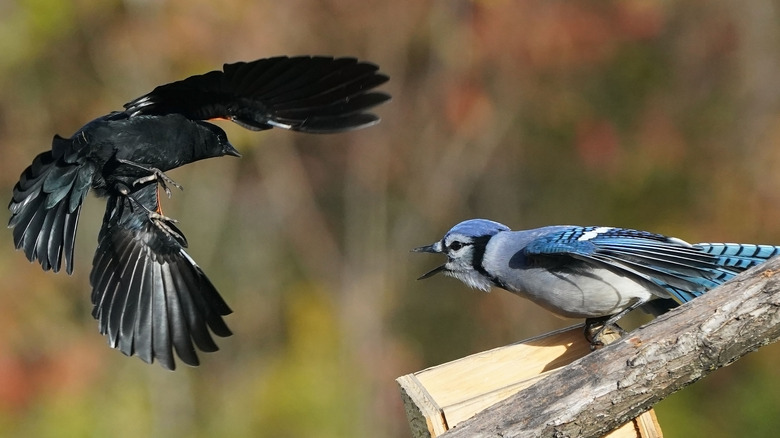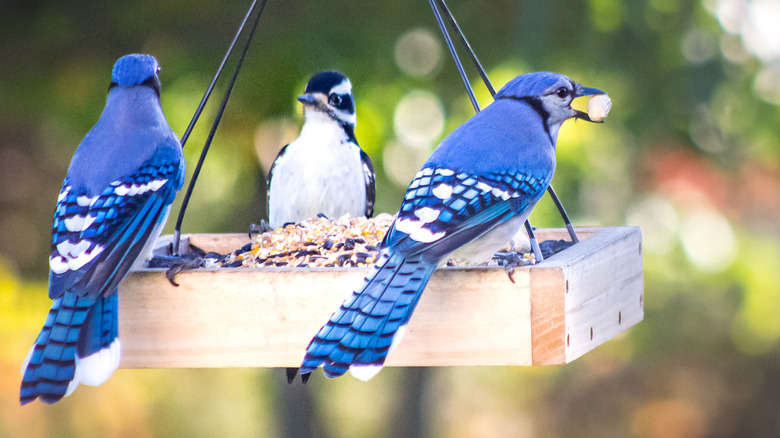There are many benefits of having bird feeders in your yard. Spying robins, chickadees, cardinals, and orioles filling up at close range is a delight. However, you may not enjoy the same variety of species if blue jays (Cyanocitta cristata) make an appearance. Common enough to lend their name to Toronto’s baseball team, blue jays are well-known and widespread. With habitat stretching from Canada to the Gulf Coast, the Atlantic shoreline to the Rockies and beyond, blue jays are as familiar to Americans and Canadians as any other bird. Their striking plumage makes them stand out among other common avian species. With black and white stripes on varying shades of blue, a brilliant white or gray chest, black facial markings, and a blue crest that makes the bird look more imposing, these feathered friends are a dazzling sight for people who haven’t encountered them before. However, while they look striking, you may not want to attract them to your yard because they can be aggressive towards other birds, driving them away.
This member of the corvid family that includes crows, ravens, and magpies is as intelligent and overbearing as its kin. Jays and other corvids are adept at foiling feeders designed to keep them out. Their calls are anything but dulcet, and if a flock of blue jays gets comfortable in your yard, you’re likely to see fewer species hanging around. Learn facts about blue jay behavior and how to keep them from becoming a permanent fixture at your feeders.
Why do blue jays have a bad reputation?

Along with brown-headed cowbirds, common grackles, and European starlings, blue jays are considered among the top birds you do not want to be seeing in your yard. John James Audubon, the ornithologist who lent his name to the highly-respected Audubon Society, did his part to stoke dislike for the corvid when he accused blue jays of “selfishness, duplicity, and malice” (per Audubon). The birding community has widely adopted this perspective, and there are genuine reasons for the feelings of animosity.
Not only are they common, they also scream out for attention — literally — with a raucous call and an ability to mimic birds of prey. These eye-catching and highly-intelligent birds are fascinating to watch. However, if blue jays are frequent visitors to your bird feeders, you may see fewer other species alighting for a meal. Known for being noisy bullies, blue Jays intimidate smaller perching birds with territorial behavior and aggression, imitating the cry of the predatory red shouldered or broad-winged hawks. This often successfully drives smaller birds away, and without competition at feeders, blue jays can gobble up expensive seed at an alarming rate.
These birds are also known as nest-robbers. You may see flashes of blue wings around backyard nests as the jays make a meal of other birds’ eggs. However, unpleasant as that sounds, this doesn’t happen as frequently as you might fear. They rarely steal eggs and instead mainly eat greens, fruits, and seeds.
How to keep blue jays away from your feeders

Suburban yards and mixed wooded areas are a prime habitat for blue jays, and they tend to steer clear of coniferous woods. The two trees that are most likely to attract blue jays are oaks and beeches. If you live in areas that provide blue jays’ favored habitat, don’t despair. There are safe strategies that dissuade them from making your yard a regular hangout without harming them. The best strategies are choosing the right seeds, using tricky feeders, and possibly carving out a special habitat for them if you have a large yard.
If you want to keep blue jays away, avoid peanuts, the birds’ favorite snack. Instead, you could use nyjer seeds, which don’t appeal to jays but tempt finches and siskins to your spaces. Corvids are adept at problem solving, and most “pest-proof” bird feeders are no match for these backyard visitors. Yet, Droll Yankees’ Whipper feeders, available at Ace Hardware, tend to stave off blue jays as well as squirrels and other unwanted diners.
If you’re lucky to have a large yard or acreage, you may be able to prevent blue jays from dominating your yard by attracting them to a separate feeding area. Hanging platform feeders are one of the best feeders for blue jays. Pick an area far from your main feeders, and if you keep the space well-stocked with food and water, this could satisfy them enough to avoid your other feeders and feathered friends.



